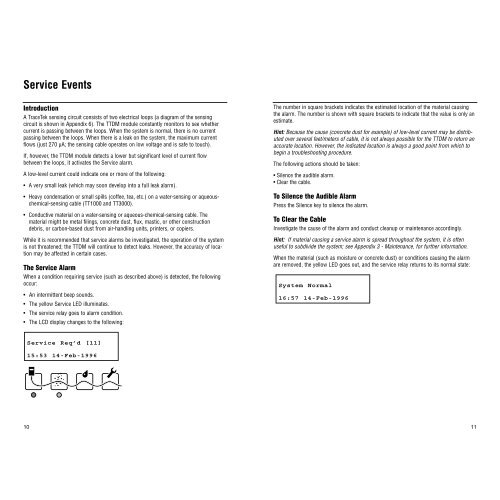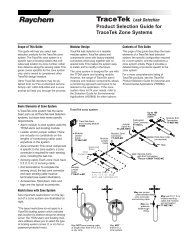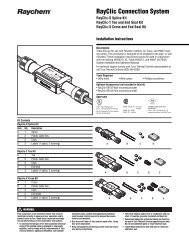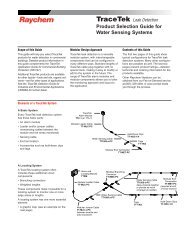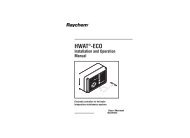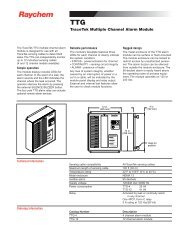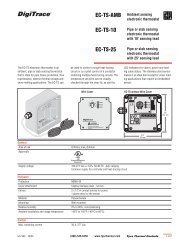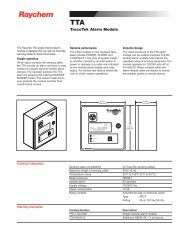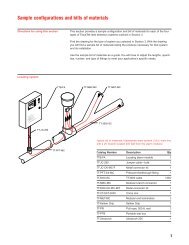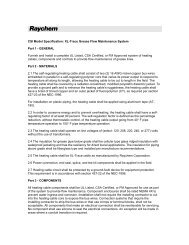TTDM Operation and Maintenance Manual - California Detection ...
TTDM Operation and Maintenance Manual - California Detection ...
TTDM Operation and Maintenance Manual - California Detection ...
You also want an ePaper? Increase the reach of your titles
YUMPU automatically turns print PDFs into web optimized ePapers that Google loves.
Service Events<br />
Introduction<br />
A TraceTek sensing circuit consists of two electrical loops (a diagram of the sensing<br />
circuit is shown in Appendix 6). The <strong>TTDM</strong> module constantly monitors to see whether<br />
current is passing between the loops. When the system is normal, there is no current<br />
passing between the loops. When there is a leak on the system, the maximum current<br />
flows (just 270 µA; the sensing cable operates on low voltage <strong>and</strong> is safe to touch).<br />
If, however, the <strong>TTDM</strong> module detects a lower but significant level of current flow<br />
between the loops, it activates the Service alarm.<br />
A low-level current could indicate one or more of the following:<br />
• A very small leak (which may soon develop into a full leak alarm).<br />
• Heavy condensation or small spills (coffee, tea, etc.) on a water-sensing or aqueouschemical-sensing<br />
cable (TT1000 <strong>and</strong> TT3000).<br />
• Conductive material on a water-sensing or aqueous-chemical-sensing cable. The<br />
material might be metal filings, concrete dust, flux, mastic, or other construction<br />
debris, or carbon-based dust from air-h<strong>and</strong>ling units, printers, or copiers.<br />
While it is recommended that service alarms be investigated, the operation of the system<br />
is not threatened; the <strong>TTDM</strong> will continue to detect leaks. However, the accuracy of location<br />
may be affected in certain cases.<br />
The Service Alarm<br />
When a condition requiring service (such as described above) is detected, the following<br />
occur:<br />
• An intermittent beep sounds.<br />
• The yellow Service LED illuminates.<br />
• The service relay goes to alarm condition.<br />
• The LCD display changes to the following:<br />
The number in square brackets indicates the estimated location of the material causing<br />
the alarm. The number is shown with square brackets to indicate that the value is only an<br />
estimate.<br />
Hint: Because the cause (concrete dust for example) of low-level current may be distributed<br />
over several feet/meters of cable, it is not always possible for the <strong>TTDM</strong> to return an<br />
accurate location. However, the indicated location is always a good point from which to<br />
begin a troubleshooting procedure.<br />
The following actions should be taken:<br />
• Silence the audible alarm.<br />
• Clear the cable.<br />
To Silence the Audible Alarm<br />
Press the Silence key to silence the alarm.<br />
To Clear the Cable<br />
Investigate the cause of the alarm <strong>and</strong> conduct cleanup or maintenance accordingly.<br />
Hint: If material causing a service alarm is spread throughout the system, it is often<br />
useful to subdivide the system; see Appendix 3 - <strong>Maintenance</strong>, for further information.<br />
When the material (such as moisture or concrete dust) or conditions causing the alarm<br />
are removed, the yellow LED goes out, <strong>and</strong> the service relay returns to its normal state:<br />
System Normal<br />
16:57 14-Feb-1996<br />
Service Req’d [11]<br />
15:53 14-Feb-1996<br />
10 11


